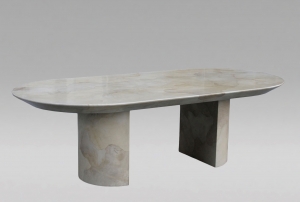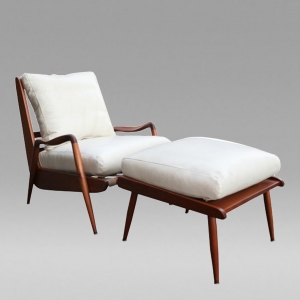|
Displaying items by tag: Studio Furniture
Revered as the “Dean of American Craftsmen,” Wharton Harris Esherick played a pivotal role in establishing the American Studio Furniture Movement. A visionary in the truest sense, Esherick was the first craftsman to approach furniture as sculpture -- a notion that influenced an entire generation of designer-craftsmen, including Arthur Espenet Carpenter, Sam Maloof, and Wendell Castle (read more about Wendell Castle and his latest work).
A trained painter and printmaker, Esherick’s fascination with wood began in 1920, when he started carving designs on the frames for his paintings. Soon, he was carving woodcuts and crafting sinuous organic sculptures, furniture, and architectural interiors...
Continue reading this article about Wharton Harris Esherick at Moderne Gallery on InCollect.com.

In his seminal book, Modern Americana: Studio Furniture from High Craft to High Glam (Rizzoli), Todd Merrill, a New York-based dealer of mid-to-late 20th century design and studio furniture, describes Karl Springer as having a “flair for glamour without ostentation.” Using exotic materials, bold proportions, and striking colors, Springer took classic forms and made them his own. His aesthetic was a perfect match for the glittering Disco Decade, and in the late 1970s through the mid-1980s, Springer was one of the most well-regarded and in-demand mid century modern designers in the world.
Born in Berlin in 1931, Springer studied bookbinding and worked as a window dresser at a prominent clothier before leaving for New York in the late 1950s. At the age of twenty-six, Springer began styling windows at Lord & Taylor. In an effort to advance his career, he started applying his bookbinding skills to making jewel boxes, desk accessories, and telephone tables, which he expertly wrapped in animal skin. Soon, his work was garnering attention from the upper echelon, including a buyer for Bergdorf Goodman and the Duchess of Windsor, who introduced Springer to an array of high-end clients.
Visit InCollect.com to read more about the mid century modern design master, Karl Springer.
George Nakashima’s furniture explores the dichotomy between strength and fragility. Carved from magnificent pieces of rich, often rare, wood, his works are spare and elegant -- the result of a formal education in architecture as well as extensive exposure to European Modernism, Eastern religious philosophy, and Japanese craft traditions.
Nakashima’s profound reverence for wood dates back to his childhood in Spokane, Washington. It was there, amongst the towering forests of the Olympic Peninsula, that he developed an abiding admiration for the inherent beauty of wood.
Visit InCollect.com. to read more about George Nakashima.
Few individuals have had as profound an effect on American furniture design as Paul Evans (1931-1987). A leading figure in the midcentury American studio furniture movement, Evans consistently pushed boundaries with his innovative approaches to metalsmithing and furniture-making. His transcendent works, which defied what everyday objects looked like and how they were made, continue to reveal the fascinating crosscurrents between sculpture and design.
Evans began working with metal in the early 1950s -- first at the Rochester Institute of Technology’s School for American Craftsmen (SAC) in Rochester, New York, where he studied under the influential American silversmiths and designers John (Jack) Prip and Lawrence Copeland, and later at the Cranbrook Academy of Art in Bloomfield Hills, Michigan.

During the early twentieth-century, mass-production dominated how products were manufactured in the United States. Automated factories churned out huge amounts of standardized products, including everything from automobiles to furniture. In response to this widespread conformity, many American designers began creating works grounded in historic traditions, favoring the handcrafted over the machine-made, the unique over the commonplace.
The Delaware Valley and Pennsylvania’s bucolic Bucks County became centers for the production of these thoughtfully-made works. In the 1940s, the Japanese-American woodworker George Nakashima settled in New Hope, Pennsylvania, where he established a studio and a reputation as a leading member of the first generation of American Studio furnituremakers. Nakashima was joined by a swathe of iconic craftsmen, including Phillip Lloyd Powell, Paul Evans, and Robert Whitley, all of whom produced custom-designed functional furniture that blurred the lines between craft, sculpture, and design.
If you've ever been to the Philadelphia Museum of Art, you know that furniture was our first art, the one in which North American makers produced work that competed in craft and originality with any in the world. David Ebner, born in 1945, places himself in this tradition when he speaks of the 1,300 or so pieces he has made in his career as "antiques of the future."
Not Ikea, in other words.
The 60 works in "David N. Ebner: 50 Years of Studio Furniture," at Moderne Gallery through Aug. 31, span his entire career, from student days until now.
Since the mid-1950s, Massachusetts has seen a growth in the production of studio furniture. Many influential makers who trained and worked in the Bay State, like Tom Loeser, Alphonse Mattia, and Rich Tannen (Fig. 1), have carried forward the tradition by teaching furniture design in schools around the country. Today, studio furniture in Massachusetts spans the stylistic poles—from interpretations of historical prototypes to nonfunctional, sculptural, and conceptual works—earning its makers national and international acclaim.
|
|
|
|
|